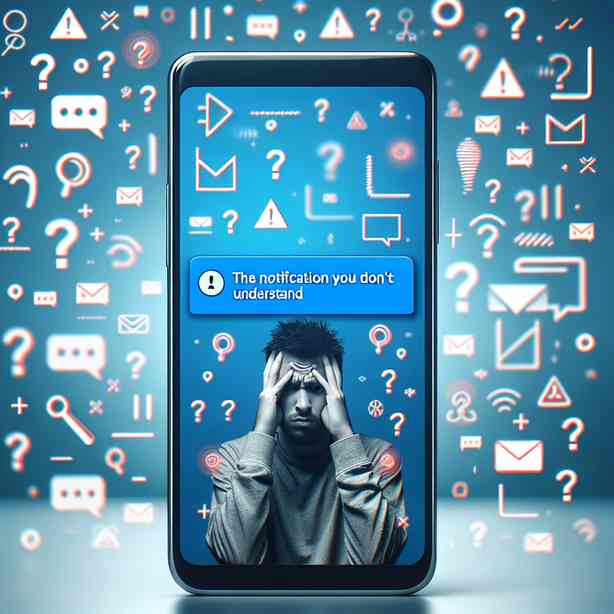
In today’s hyper-connected world, notifications alert us to various events, updates, and messages on a daily basis. While these notifications are often helpful, they can also become a source of confusion. The phrase “The Notification You Don’t Understand” highlights the idea that, in the midst of endless information, there are messages that can be ambiguous, overwhelming, or even alarming. This article delves into the complexity of notifications, exploring their implications, the psychology behind them, and strategies for managing them effectively.
The advent of mobile technology has led to an explosion of notifications. Whether it’s alerts from social media, reminders for appointments, or updates from your favorite apps, our devices are constantly buzzing, pinging, and flashing. Each notification seeks our attention, promising information that is either urgent, useful, or entertaining. However, among this stream of notifications are those that leave us perplexed, unsure of their meaning, or their importance.
Understanding the psychology of notifications can shed light on why some messages cause confusion. Notifications are designed to be attention-grabbing, and many are crafted to evoke an emotional response. For instance, an alert about breaking news might trigger anxiety or curiosity, whereas a reminder about an upcoming event might cause stress if you feel unprepared. This emotional weight can make it difficult to process the content of the notification, especially if it is not written clearly or lacks context.
One common source of confusion lies in the language used in notifications. Many apps utilize jargon, abbreviations, or technical terms that may not be familiar to all users. For instance, a notification that reads “System Update Available” may be straightforward for tech-savvy individuals, but for others, it could raise questions about what that entails—Is it safe? Will it change how the app works? Why is it important? These uncertainties can result in user frustration.
Moreover, notifications often blend together in our minds. As we receive multiple alerts from various applications, it can become increasingly challenging to categorize and remember each one. When notifications run together, important messages may be overlooked or misinterpreted. This phenomenon is especially prevalent in professional settings, where an influx of notifications can lead to information overload, making it difficult to discern which alerts are urgent and which are not.
For example, consider a workplace where team members receive notifications about both ongoing projects and personal tasks. If the notification from a project management tool is phrased similarly to a personal reminder, such as “Meeting in 10 minutes,” it may become easy to dismiss or overlook critical work notifications. This situation can become particularly detrimental in fast-paced environments where clarity is essential for effective communication and task management.
Understanding the implications of confusing notifications extends beyond mere frustration. It can impact productivity, decision-making, and even mental health. In scenarios where one feels overwhelmed by notifications, stress levels can rise, leading to burnout or a sense of chaos. Therefore, it is necessary to adopt strategies that help manage notifications effectively and reduce confusion.
First and foremost, it’s essential to customize notification settings across your devices and applications. Many platforms allow users to choose which notifications to receive and how they are presented. By prioritizing notifications that are genuinely important, users can substantially reduce clutter and confusion. For instance, one might opt to receive immediate notifications from a work-related app while silencing alerts from social media during work hours.
Another practical strategy is to employ a daily or weekly review of notifications and tasks. Setting aside dedicated time to go through missed notifications can help users sort through information at their own pace, allowing them to focus only on what truly matters. This practice not only minimizes the feeling of being overwhelmed but also encourages reflection on what notifications are genuinely valuable and relevant.
Additionally, fostering a culture of clear communication within professional environments can significantly mitigate confusion related to notifications. Employers can encourage team members to use clear and concise language in messages and adopt standardized terminologies that everyone understands. This approach promotes clarity and assures everyone is on the same page regarding communication expectations.
Finally, taking breaks from technology can also be immensely beneficial. A digital detox—where one temporarily disconnects from devices—can provide a much-needed mental reset. During this time, individuals can focus on their surroundings, engage in mindfulness practices, and reduce the constant bombardment of notifications. Such breaks foster a healthier relationship with technology and promote a greater sense of control over one’s attention.
In conclusion, “The Notification You Don’t Understand” serves as a reminder of the complexity of modern communication. As we navigate a world filled with countless alerts and updates, it’s essential to acknowledge the potential for confusion and frustration. By understanding the psychological impact of notifications, customizing our notification settings, employing regular reviews, fostering clear communication, and taking necessary breaks, we can regain control over our digital environments. Ultimately, creating a more manageable and less overwhelming relationship with notifications will allow us to enhance our productivity and well-being in both personal and professional spheres.


